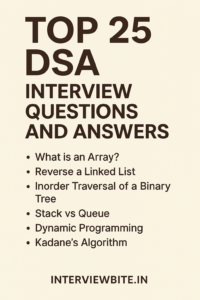Preparing for tech interviews? Mastering Data Structures and Algorithms (DSA) in Java is essential to crack interviews at companies like Amazon, Infosys, TCS, Google, and other top product or service-based companies.
In this article, we’ll cover the most commonly asked Java DSA interview questions with simple code examples, explanations, and best practices.
🔹 1. What are the key data structures used in Java?
Java provides a wide range of built-in data structures:
- Array
- ArrayList
- LinkedList
- HashMap
- HashSet
- Stack
- Queue
- TreeMap
- PriorityQueue
These are available under the java.util package and form the base of most DSA questions in interviews.
🔹 2. Reverse a Linked List in Java (Iterative)
javaCopyEditclass Node {
int data;
Node next;
}
public Node reverse(Node head) {
Node prev = null;
Node current = head;
while (current != null) {
Node next = current.next;
current.next = prev;
prev = current;
current = next;
}
return prev;
}
📌 Asked by: Cognizant, Capgemini
🔹 3. Implement a Stack using Array in Java
javaCopyEditclass Stack {
int top = -1;
int[] stack = new int[100];
void push(int val) {
if (top < stack.length - 1) {
stack[++top] = val;
}
}
int pop() {
if (top >= 0) {
return stack[top--];
}
return -1;
}
}
✅ Key Concepts: Array, OOP, Stack operations
🔹 4. Find the First Non-Repeating Character in a String
javaCopyEditpublic char firstNonRepeating(String s) {
int[] freq = new int[256];
for (char c : s.toCharArray()) freq[c]++;
for (char c : s.toCharArray()) {
if (freq[c] == 1) return c;
}
return '_';
}
🔹 5. What is the difference between ArrayList and LinkedList?
| Feature | ArrayList | LinkedList |
|---|---|---|
| Access Time | Fast (O(1)) | Slow (O(n)) |
| Insertion/Deletion | Slower (O(n)) | Faster (O(1) at head) |
| Memory Usage | Less | More (due to pointers) |
✅ Use Case: Use ArrayList for fast access, LinkedList for fast insertions.
🔹 6. Java Program to Detect Loop in a Linked List
javaCopyEditpublic boolean hasLoop(Node head) {
Node slow = head, fast = head;
while (fast != null && fast.next != null) {
slow = slow.next;
fast = fast.next.next;
if (slow == fast) return true;
}
return false;
}
📌 Asked in: Accenture, Infosys, Wipro
🔹 7. Explain HashMap and how it works internally.
- HashMap stores key-value pairs.
- Internally uses hashing to locate the bucket.
- Handles collisions using chaining (LinkedList) or open addressing.
- Complexity: O(1) average, O(n) worst-case for
get()andput().
🔹 8. Java Program for Binary Search
javaCopyEditpublic int binarySearch(int[] arr, int key) {
int low = 0, high = arr.length - 1;
while (low <= high) {
int mid = (low + high) / 2;
if (arr[mid] == key) return mid;
if (arr[mid] < key) low = mid + 1;
else high = mid - 1;
}
return -1;
}
🔹 9. What is TreeSet in Java?
- Stores unique elements in sorted (ascending) order.
- Based on Red-Black Tree.
- Operations like
add(),remove(),contains()take O(log n).
🔹 10. Java Code for Depth-First Search (DFS) in a Graph
javaCopyEditvoid dfs(int v, boolean[] visited, List<List<Integer>> graph) {
visited[v] = true;
System.out.print(v + " ");
for (int u : graph.get(v)) {
if (!visited[u]) {
dfs(u, visited, graph);
}
}
}
📌 Pro Tips for Java DSA Interviews
- Always explain time and space complexity
- Use Java’s Collections Framework smartly
- Practice on platforms like LeetCode, GeeksforGeeks, and InterviewBit
- Be prepared to optimize your solution if asked
🔚 Final Thoughts
Mastering DSA in Java is crucial if you want to crack technical rounds confidently. The questions listed above cover beginner to intermediate concepts with real interview-level depth. Be sure to practice writing Java code under timed conditions.
